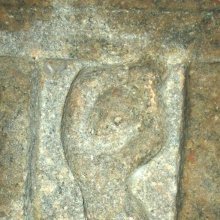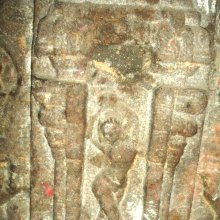Vivarta: 13 definitions
Introduction:
Vivarta means something in Hinduism, Sanskrit, Hindi. If you want to know the exact meaning, history, etymology or English translation of this term then check out the descriptions on this page. Add your comment or reference to a book if you want to contribute to this summary article.
Alternative spellings of this word include Vivart.
Images (photo gallery)
In Hinduism
Vaishnavism (Vaishava dharma)
Source: ISKCON Press: GlossaryVivarta (विवर्त).—Illusion; also, sorrow and confusion due to nonfulfillment of material desires.

Vaishnava (वैष्णव, vaiṣṇava) or vaishnavism (vaiṣṇavism) represents a tradition of Hinduism worshipping Vishnu as the supreme Lord. Similar to the Shaktism and Shaivism traditions, Vaishnavism also developed as an individual movement, famous for its exposition of the dashavatara (‘ten avatars of Vishnu’).
Purana and Itihasa (epic history)
Source: archive.org: Shiva Purana - English TranslationVivarta (विवर्त) refers to the “whirlwinds” that were seen at the time of the destruction of Dakṣa’s sacrifice, according to the Śivapurāṇa 2.2.34. Accordingly, as Brahmā narrated to Nārada:—“[...] When Vīrabhadra set off thus, bad omens were seen by Dakṣa and the Devas. [...] Rough winds raising a lot of dust blew there. Locusts and moths were tossed about by whirlwinds (vivarta)”.

The Purana (पुराण, purāṇas) refers to Sanskrit literature preserving ancient India’s vast cultural history, including historical legends, religious ceremonies, various arts and sciences. The eighteen mahapuranas total over 400,000 shlokas (metrical couplets) and date to at least several centuries BCE.
Vedanta (school of philosophy)
Source: Shodhganga: Siva Gita A Critical StudyVivarta (विवर्त) or Vivartakāraṇa refers to “an apparent or illusory form”: an unreal appearance caused by avidyā or human error. This is favourite doctrine of the Vedāntins according to whom visible world is a mere illusion while Brahman or Supreme spirit is the only real entity; as a serpent is a vivarta of rope, so is the world a vivarta of the real entity Brahman, and the illusion is removed by Vidyā or true knowledge.

Vedanta (वेदान्त, vedānta) refers to a school of orthodox Hindu philosophy (astika), drawing its subject-matter from the Upanishads. There are a number of sub-schools of Vedanta, however all of them expound on the basic teaching of the ultimate reality (brahman) and liberation (moksha) of the individual soul (atman).
Languages of India and abroad
Sanskrit dictionary
Source: DDSA: The practical Sanskrit-English dictionaryVivarta (विवर्त).—
1) Turning round, revolving, whirling.
2) Rolling onward, moving about; संवर्तप्रकटविवर्तसप्तपाथोनाथोर्मि- व्यतिकरविभ्रमप्रचण्डः (saṃvartaprakaṭavivartasaptapāthonāthormi- vyatikaravibhramapracaṇḍaḥ) Mv.6.26.
3) Rolling back, returning.
4) Dancing.
5) Alteration, modification, change of form, altered condition or state; शब्दब्रह्मणस्तादृशं विवर्त- मितिहासं रामायणं प्रणिनाय (śabdabrahmaṇastādṛśaṃ vivarta- mitihāsaṃ rāmāyaṇaṃ praṇināya) Uttararāmacarita 2; एको रसः करुण एव निमित्त- भेदाद्भिन्नः पृथक् पृथगिवाश्रयते विवर्तान् (eko rasaḥ karuṇa eva nimitta- bhedādbhinnaḥ pṛthak pṛthagivāśrayate vivartān) Uttararāmacarita 3.47; अकाण्डशुष्काशनि- पातरौद्रः क एष धातुर्विषमो विवर्तः (akāṇḍaśuṣkāśani- pātaraudraḥ ka eṣa dhāturviṣamo vivartaḥ) Mv.5.57.
6) (In Vedānta phil.) An apparent or illusory form, an unreal appearance caused by अविद्या (avidyā) or human error; (this is a favourite doctrine of the Vedāntins according to whom the whole visible world is a mere illusion--an unreal and illusory appearance--while Brahman or Supreme Spirit is the only real entity; as a serpent (sarpa) is a vivarta of a rope (rajju), so is the world a vivarta of the real entity Brahman, and the illusion is removed by Vidyā or true knowledge; cf. Bhavabhūti :-विद्या- कल्पेन मरुता मेघानां भूयसामपि । ब्रह्मणीव विवर्तानां क्वापि विप्रलयः कृतः (vidyā- kalpena marutā meghānāṃ bhūyasāmapi | brahmaṇīva vivartānāṃ kvāpi vipralayaḥ kṛtaḥ) || Uttararāmacarita 6.6).
7) A heap, multitude, collection, an assemblage.
Derivable forms: vivartaḥ (विवर्तः).
Source: Cologne Digital Sanskrit Dictionaries: Edgerton Buddhist Hybrid Sanskrit DictionaryVivarta (विवर्त).—(m. ? to vivartati 2), with or sc. kalpa, (period of) evolution of the world, after a periodic destruc- [Page499-b+ 71] tion (saṃvarta); so Pali vivaṭṭa and saṃvaṭṭa (mis- defined [Pali Text Society’s Pali-English Dictionary], which precisely inverts the mgs.; Childers is correct; see notably Vism. 419.29 ff. which is completely clear, and consistent with [Buddhist Hybrid Sanskrit]); °ta-kalpaḥ Mahāvyutpatti 8280, saṃvarta-k° 8279; caturaśīti-saṃvartavivarta-sthito Mahāvastu i.63.6, (the Lord) abides thru 84 periods of destruction and (new) evolution (see passage s.v. vivartati 2); yāvat saṃvartakalpam api vivartakalpam api saṃvarta-vivarta- kalpam api anekāny api saṃvartavivartakalpāny anusma- rati sma (sc. the Buddha) Lalitavistara 345.11—12; similarly Mahāvastu i.229.1 ff.; ii.284.10 ff.; and substantially ii.133.1—2, where mss. are more confused, one (followed by Senart) anekāpi saṃvartakalpā vā anekāpi saṃvartā anekāpi vivartā anekāpi saṃvartavivartakalpā (the other ms. always kalpā after vi° and saṃ°); saṃvarta (v.l. °taṃ) ca vivarta (v.l. °taṃ; so mss.) ca aśītiṃ tena karmaṇā (a virtuous act), durgatiṃ nopalabhate…Mahāvastu i.268.8 (verse); saṃvarta- vivartaṃ…prajānāti Bodhisattvabhūmi 253.14; saṃvarta-vivarta- kalpān avataranti (2d ed. correctly °rati) sma Gaṇḍavyūha 277.25; compare Abhidharmakośa LaV-P. iii.181 ff. (et al., Index). In Mahāvastu i.63.13 vivarta-caryā is used only in an attempt to explain avivarta-caryā, q.v.
Source: Cologne Digital Sanskrit Dictionaries: Benfey Sanskrit-English DictionaryVivarta (विवर्त).—i. e. vi-vṛt + a, m. 1. Going round, [Lassen, Anthologia Sanskritica.] 74, 16; revolving. 2. Dancing. 3. Confounding of truth and falsehood, mistaking unreal objects and conceiving them to be what they are not, e. g. mirage for water, [Vedāntasāra, (in my Chrestomathy.)] in
Vivarta (विवर्त).—[masculine] the turning or revolving one, i.e. the sky; whirl-pool, eddy; change, altered condition; the mere semblance of (—°).
Source: Cologne Digital Sanskrit Dictionaries: Monier-Williams Sanskrit-English Dictionary1) Vivarta (विवर्त):—[=vi-varta] a vi-vartana etc. See under vi-√vṛt, p.988.
2) [=vi-varta] [from vi-vṛt] b m. ‘the revolving one’, Name of the sky, [Vājasaneyi-saṃhitā; Taittirīya-saṃhitā]
3) [v.s. ...] a whirlpool, [Sāma-veda]
4) [v.s. ...] turning round, rolling onwards, moving about, [Mahāvīra-caritra]
5) [v.s. ...] turning away, [cf. Lexicographers, esp. such as amarasiṃha, halāyudha, hemacandra, etc.]
6) [v.s. ...] dance, [cf. Lexicographers, esp. such as amarasiṃha, halāyudha, hemacandra, etc.]
7) [v.s. ...] changing from one state to another, modification, alteration, transformation, altered form or condition, [Kāvya literature; Kathāsaritsāgara]
8) [v.s. ...] (in Vedānta) error, illusion, an apparent or illusory form, unreality (caused by A-vidyā, ‘ignorance’, and removed by Vidyā, ‘true knowledge’), [Vedāntasāra]
9) [v.s. ...] collection, multitude, [cf. Lexicographers, esp. such as amarasiṃha, halāyudha, hemacandra, etc.]
10) [v.s. ...] (with atreḥ) Name of two Sāmans, [Ārṣeya-brāhmaṇa]
Source: DDSA: Paia-sadda-mahannavo; a comprehensive Prakrit Hindi dictionary (S)Vivarta (विवर्त) in the Sanskrit language is related to the Prakrit words: Viaṭṭa, Viatta, Viuṭṭa.
[Sanskrit to German]
Sanskrit, also spelled संस्कृतम् (saṃskṛtam), is an ancient language of India commonly seen as the grandmother of the Indo-European language family (even English!). Closely allied with Prakrit and Pali, Sanskrit is more exhaustive in both grammar and terms and has the most extensive collection of literature in the world, greatly surpassing its sister-languages Greek and Latin.
Hindi dictionary
Source: DDSA: A practical Hindi-English dictionaryVivarta (विवर्त) [Also spelled vivart]:—(nm) a whirlpool; illusion, falsity; ~[na] going round; shifting; crisis; ~[vāda/~vāditā ] the Vedantic theory which propounds the unreality of the world and opines that it is a mere illusion; ~[vādī] a believer in the doctrine named ~[vāda]; pertaining to ~[vāda]; hence [vivartita] (a).
...
Kannada-English dictionary
Source: Alar: Kannada-English corpusVivarta (ವಿವರ್ತ):—
1) [noun] a turning around; a rolling onward; a moving about.
2) [noun] a collection; a multitude.
3) [noun] (phi.) an error, illusion; an apparent or illusory form; unreality caused by ignorance (which can be removed by knowledge).
4) [noun] (dance.) a turning of the eye-balls in the corner of the eyes.
Kannada is a Dravidian language (as opposed to the Indo-European language family) mainly spoken in the southwestern region of India.
Nepali dictionary
Source: unoes: Nepali-English DictionaryVivarta (विवर्त):—n. 1. turning round; revolving; whirling; 2. rolling onward; 3. rolling back; returning; 4. alteration; modification; change of form; 5. illusion; bewilderment;
Nepali is the primary language of the Nepalese people counting almost 20 million native speakers. The country of Nepal is situated in the Himalaya mountain range to the north of India.
See also (Relevant definitions)
Starts with: Vivartakalpa, Vivartakarana, Vivartan, Vivartana, Vivartananritya, Vivartani, Vivartaniya, Vivartate, Vivartati, Vivartaushtha, Vivartavada.
Query error!
Full-text (+2): Vivartavada, Lakshmivivarta, Vaikritavivarta, Vivartakalpa, Vaivarta, Vastuvivarta, Avivarta, Vivartana, Vivart, Vivartaushtha, Vivartakarana, Vivartananritya, Vivartin, Viatta, Vivartita, Viutta, Samvarta, Avivartacarya, Vivartati, Vivartate.
Relevant text
Search found 67 books and stories containing Vivarta, Vi-varta; (plurals include: Vivartas, vartas). You can also click to the full overview containing English textual excerpts. Below are direct links for the most relevant articles:
Sahitya-kaumudi by Baladeva Vidyabhushana (by Gaurapada Dāsa)
Text 7.122 < [Chapter 7 - Literary Faults]
Pratyabhijna and Shankara’s Advaita (comparative study) (by Ranjni M.)
4. The Theory of Causality < [Chapter 3 - The nature of Universe and Individual Self in Pratybhijñā and Advaita]
Vakyapadiya of Bhartrihari (by K. A. Subramania Iyer)
Verse 3.3.81 < [Book 3 - Pada-kāṇḍa (3): Sambandha-samuddeśa (On Relation)]
Verse 3.1.35 < [Book 3 - Pada-kāṇḍa (1): Jāti-samuddeśa (On the Universal)]
Verse 3.3.63 < [Book 3 - Pada-kāṇḍa (3): Sambandha-samuddeśa (On Relation)]
A History of Indian Philosophy Volume 2 (by Surendranath Dasgupta)
Part 3 - Śaṅkara’s Defence of Vedānta < [Chapter XI - The Śaṅkara School of Vedānta (continued)]
Part 28 - Prakāśānanda (a.d. 1550—1600) < [Chapter XI - The Śaṅkara School of Vedānta (continued)]
Part 4 - Teachers and Pupils in Vedānta < [Chapter XI - The Śaṅkara School of Vedānta (continued)]
Bhagavad-gita (with Vaishnava commentaries) (by Narayana Gosvami)
Verse 9.4 < [Chapter 9 - Rāja-guhya-yoga (Yoga through the most Confidential Knowledge)]
Verse 5.16 < [Chapter 5 - Karma-sannyāsa-yoga (Yoga through Renunciation of Action)]
Chaitanya Bhagavata (by Bhumipati Dāsa)
Verse 2.20.33 < [Chapter 20 - The Glories of Murāri Gupta]
Verse 3.3.215 < [Chapter 3 - Mahāprabhu’s Deliverance of Sarvabhauma, Exhibition of His Six-armed Form, and Journey to Bengal]
Verse 2.20.39 < [Chapter 20 - The Glories of Murāri Gupta]

